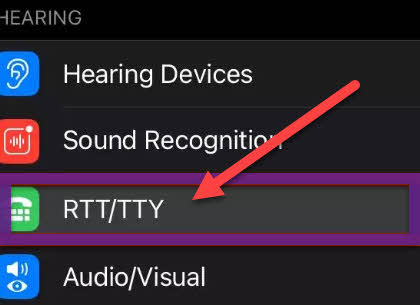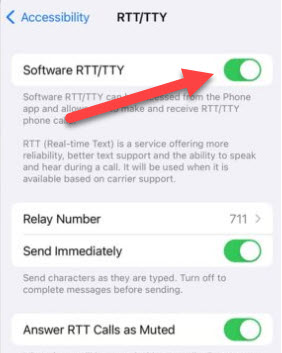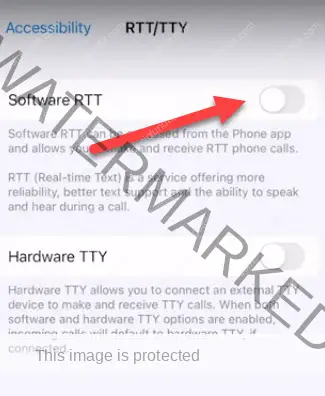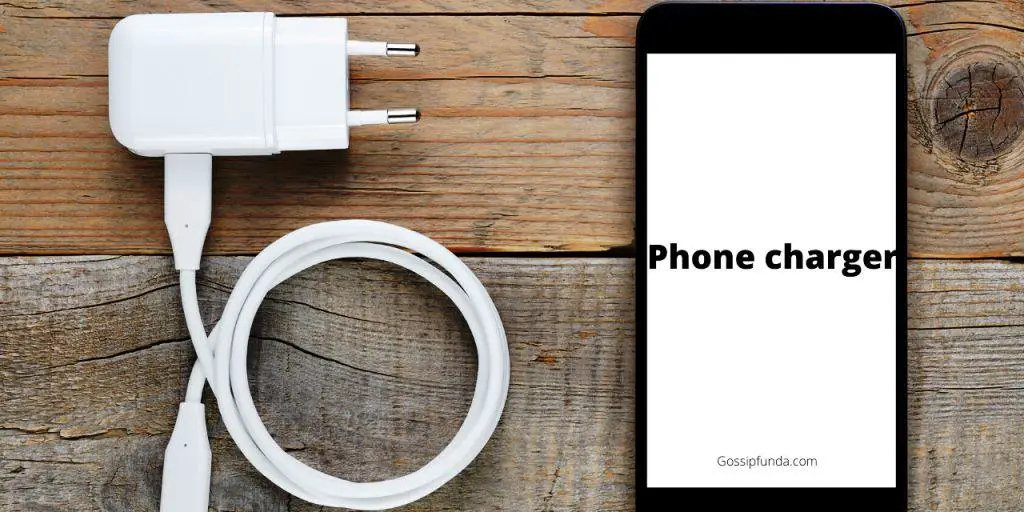If you have some trouble with hearing or speaking, you can use the mobile phone feature called RTT or real-time text on your iPhone. But sometimes we need to know how to turn off RTT on iPhones. RTT is an advanced accessibility protocol that is helpful for people with speech, and hearing difficulties to get involved in conversations. As in the case of Teletype (TTY), this feature enables you to broadcast text. RTT transits the text without turn-taking as you type and informs the recipient to read the message immediately and to communicate over the phone. TTY devices are built-in with most mobiles, as it was a means for a long time. The hearing impaired people used the TTY feature to communicate with others. In RTT calling, when you type the message, it is transmitted as audio using the RTT protocol.
RTT is a streaming text that is transmitted instantly to the receiver over Text-over-IP. To assist those who have speaking or hearing challenges, Apple has introduced this fantastic accessibility function in iPhones. The built-in teletypewriter (TTY) or real-time text (RTT) on the iPhone can be used to send messages and the receiver while they are on the line can reply instantly without the need for any additional hardware. The message is promptly transmitted as a voice message using RTT software, so the receivers can listen to it right away. RTT is available on iPhones running iOS 10 or later. Your telecommunications carrier must support RTT capability if you have to use it. Also, you can change the phone number to which the RTT is to be enabled through the mobile phone settings. But RTT and TTY are not supported by all carriers.

Setting Up RTT in iPhones
The RTT calling is a standard feature that is accompanied by all iPhone series. The availability of RTT will vary depending on the network and carrier being utilized since not all carriers in every nation or region have adopted it yet. However, the RTT tool on your iPhone can be activated and customized through the mobile phone settings. Even though you can select the preferable SIM if you are using dual SIM cards for phone calls.
Steps to be followed
The steps to be taken while setting up Real-Time Text Calling are:
- Go to the Home Screen of your iPhone
- Open Settings on your iPhone.
- Then go to the option General
- Then select the option Accessibility.
- Next, follow the steps to proceed. Here you have to decide the phone number in the case of the dual SIM mode.
- Tap RTT/TTY
- Select the SIM in the dual SIM mode
- For a mobile phone with a dual SIM card, on your iPhone, select the line (the mobile number that is supposed to use for RTT calling).
- Enable RTT/TTY software or TTY software.
- Select the SIM that is used by the RTT/TTY software
- Toggle on Software RTT/TTY

- Type the Relay Number of the Telecommunication carrier
- Go to the option Send Immediately
- Turn off or on (as per the condition of your message)
- Toggle to Enable the option Answer All Calls as RTT/TTY
- Activate the hardware

Making the RTT calls
The following are the steps to be followed for making an RTT call.
- Go to the Home Screen
- Open the phone app
- Tap on the phone number
- Select the RTT/TTY Call, or RTT/TTY Relay Call option
- Select RTT/TTY when the call got connected to the contact that you selected
- A chat box will be opened and you can type as in the case of SMS

The message will be transmitted instantly when you type if the Send Immediately option is ON (enabled). You can type and send the message after completing it when the Send Immediately option is OFF (disabled). Thus you have to enable it and press the send option. Also, you have to enable the mic option to transmit as audio.
Receiving the RTT call
Do as in the case of a phone call. Just press smoothly t the RTT icon

Advantages of RTT Calls
With the use of RTT, you can send text messages without pressing the send button after you type them. People who have trouble hearing and speaking typically use RTT, which operates on wireless devices like an iPhone. On your iPhone, you can enable RTT and save or even obtain a transcript of the RTT calls made. With the use of RTT, you can send text messages without pressing the send button after you type them. Even those who are used to TTY calls also can utilize RTT calls. People who have trouble hearing and speaking typically use RTT, which operates on wireless devices like an iPhone. On your iPhone, you can enable RTT and save or even obtain a transcript of the RTT calls made. The advantages can be specifically noted as the following
- Some of the situations where RTT becomes the only usage option
- Some TTY users wanted to send messages
- It is useful to communicate in noisy environments where a conversation is not practical
- Transfer the accurate information, where correctness is important, like numbers or some codes.
- When an immediate and fast reply is needed provided that RTT at both ends is enabled.
- When the matter to be conveyed is confidential or a secret, and cannot be talked about loudly
- People with hearing and speech impairments wanted to make conversations with normal people without delay in the flow of communication.
- To convey any text in real-time through wireless phones, RTT can avoid the need to buy specialized equipment like TTYs. RTT is fully software-reliant and the only requirement is the carrier support
- There is no turn-taking in RTT as the transmission is instant.
Coordinating with TTY
TTY does not support many languages as RTT. Also, a specialized device is needed for the implementation of TTY. To make the two technologies compatible, TTY and RTT users, including people, organizations, etc., must be able to communicate with one another. But RTT and TTY users will only be able to text one another using the TTY character set and not the RTT international character set, and they will have to turn off sending and receiving messages. The reason behind this is that TTY does not support all the language formats. But the mobile phones are to be set for both TTY and RTT calling manually.
Turn Off the RTT on iPhones
RTT is a feature that relies on the telecom provider and works with the mobile phone’s built-in devices like microphone, keyboard, wifi features, etc. So it is not dependent on any external hardware. Consider the benefits of RTT calling before disabling or turning off RTT. There is coordination existing between TTY calling and RTT calling as per the telecommunication protocols. Thus the option that is enabled in TTY hardware is to be toggled to OFF. Certain steps may vary from different versions. Thus to turn off the feature, you need to follow a few steps only.
Method1:
- Go to the Home screen
- Open settings
- Go to General
- Select Accessibility
- Select RTT/TTY option
- For a mobile phone with a dual SIM card, on your iPhone, select the line.
- Enable RTT/TTY software or TTY software (also called an RTT soft switch).
- Touch Transfer Number and then enter the phone number used to transfer calls using the RTT/TTY software
- Toggle it to OFF
- Exit the screen
Method2:
- Go to Settings from Home Screen
- Select General
- Select Accessibility
- Tap on Call Audio Routing.
- Select the option Manual
- Disable the soft switch for RTT calling
Method 3:
- Go to the home screen
- Open Settings
- Go to Availability
- Select the LISTEN section
- Select RTT/TTY
- Select the RTT soft switch or RTT/TTY soft switch to deactivate
- Then toggle the hardware TTY switch to disable (to stop TTY calling)
Method 4:
To Deactivate call waiting press the End call icon
Method 5:
If you are still interrupted by RTT calls after removing the RTT capabilities from your mobile phone, instruct or request (as per the situation) the sender to take the following action with the sender’s phone.
- Open Settings
- Go to General
- Select Accessibility
- Toggle RTT/TTY to OFF
Hardware TTY is the option to enable or disable the hardware components used in the TTY Calling. While disabling the RTT calling this option also is to be disabled as there is a provision to make RTT calls from a TTY calling device

The charges apply
All the Telecomm carriers make charges as per the tariffs for online calls. Even though RTT is a software base feature, it depends highly on the network configuration and the speed of the Internet
Factors Affecting the RTT Calling
- Distance between the nodes, the transmission and receiving points
- Transmission medium used (wired or wireless medium)
- Network hops (intermediate connections occurred or happened while transferring the data packets from one segment to another)
- Data Traffic volume (is the number of data packets moving across the network at the given time)
- Server response time for transmissions on the wireless mode of communication
- Latency period while transmitting from the sender to receiving point
Read Also: no caller id vs unknown caller
Conclusion
RTT calling is a mobile phone feature available on almost all the new generation smartphones. The RTT calling is very much useful for people with hearing and speech difficulties. Setting the RTT calling on a mobile phone can be done in easy steps. It is a straightforward process that can be started from the phone Settings and following the steps in order.
While enabling the RTT calling from your iPhone, the TTY hardware option also is to be enabled to use both. It implements the network transmission protocols to transfer the text over IP. When the RTT feature is no longer needed, you can disable it with a few steps. Additionally, RTT users can use the TTY feature as the iPhone has the compatibility to use both. The RTT supports International language formats. Any how certain pitfalls come with the RTT feature also. The efficiency of transmission depends on the capacity of the wireless carrier. Also, latency may occur due to high network traffic. The charge for RTT calling depends on the tariff for online calls.
FAQs
RTT or Real-Time Text is a feature provided by mobile phone manufacturers mainly to help people with hearing and speech difficulties. The message that you type appears to the other end in real-time. The telecom carriers should allow the support to use it on your phone. There are situations where we have to use this feature. It can be used for passing an urgent message or communicating an important confidential matter. It can be used when you wanted to communicate with somebody in a noisy environment where a call is not possible. The sole factor to take into account in an RTT calling is the tariff charges by the carrier. Those with hearing and speech difficulties can type the message and involve in the conversation with others using TTY or RTT. TTY supports certain formats only, but RTT supports many International Language formats.
There are options available in the phone Settings. From settings go to General. Then select the option Accessibility. Then select the RTT/TTY. Toggle software RTT and Hardware TTY to the OFF position to stop both services. While stopping RTT, it is better to turn OFF the TTY services also as there is coordination existing between both the services. After disabling this feature in your phone, unfortunately, if you are getting interrupted, then contact the sender and request the sender to change the RTT settings of the sender’s phone.
TTY calls require specialized hardware. Nowadays in smartphones, it is built in. RTT calls require no specialized hardware as it is reliable on the software and the telecommunication channel used. TTY supports a few formats, but RTT supports many International language formats. In TTY turn-taking takes place, but in RTT no turn-taking occurred as the text is immediately transmitted.
Awill Guru is a technology enthusiast with degrees in VLSI Engineering (B.Tech, M.Tech) and Android Development. Their passion for education drives them to teach and share knowledge through their blog. He also hold qualifications in Sociology (M.A.) and Education (B.Ed), along with NIELIT O and A Level certifications.


